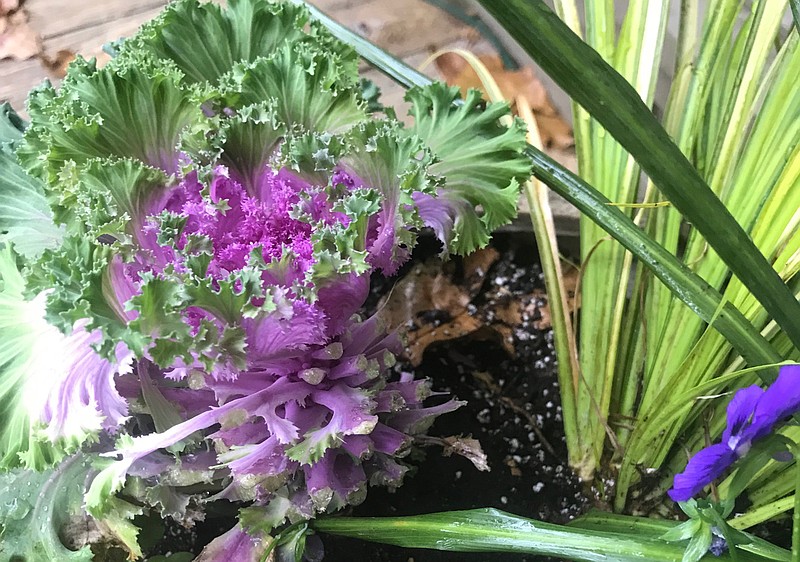Q Over the past week I have noticed ongoing damage to this ornamental kale. [The reader sent a photo.] I'm used to the squirrels burying nuts in the pots, but I've never had them snack on my kale. Suggestions?
A Put some hot pepper sauce in a spray bottle with a little water and spray it on the plant. See if that will deter them. There are other sprays you can buy to ward off animals, but they tend to have an odor, and you may not want that close to the house.
■ ■ ■
Q I'm behind on my fall yard duties. Is it too late to divide peonies and irises? Should I try to root cuttings of the Persian shield for next year? Will the lemon grass and citronella come back on their own if I do something to help them overwinter?
A You can still divide peonies, but I would not divide irises this late. Iris rhizomes have to be planted shallowly, and I am afraid they would be heaved out of the soil this winter from freezing and thawing. Take cuttings of Persian shield and citronella, since neither will come back next year. Lemongrass can come back in a milder winter, or with added mulch. You have a lot of lemon grass, and it is next to the house, so it might be more protected. It won't be a 100% guarantee, but keep your fingers crossed. If you can dig up a small plant and put it in a pot in your garage or under the crawlspace of your house, that would protect it more.
Gallery: In The Garden — November 27, 2021
Q Would you identify this bush that came up along my fence? [The reader sent a photo.] I left it because I thought the birds would enjoy the berries.
A The plant in question is an Amur honeysuckle, Lonicera maackii. In Northwest Arkansas, this plant can be quite invasive. It has pretty, fragrant white flowers in the summer, followed by these clusters of berries in the fall. Birds do eat the fruit, then drop the seeds everywhere. The plant spreads by its root system as well as by the seeds, so beware.
■ ■ ■
Q We spent a wonderful weekend in Eureka Springs and while there visited Quigley's Castle, which is where I took this [photo]. (Such a fascinating place -- you've probably been there. I could have stayed hours longer just to continue viewing the landscaping in the changing autumn light!) I was told the name of the plant but not sure of the spelling.
A The plant in question is crossandra, a lovely annual. The flowers come in a variety of shades of orange and yellow.
■ ■ ■
Q Is this sumac? We live in north Arkansas, and it began as a very tall tree with leaves at the top. Also, when do you prune Japanese maples?
A No, this small tree/large bush is a tree of heaven (Ailanthus altissima). It has compound leaves like sumac, but this plant is native to China and spreads aggressively. It produces a plume of white flowers at the top that turn into a cluster of purplish seeds. The flowers have a noxious odor, so other common names include stinking sumac (because of its similarity to sumac), and varnish tree. As to pruning Japanese maples, I prefer to do it before the trees break dormancy in the spring. Occasionally we get some winter damage on Japanese maples, so leaving them intact can give them needed protection. The best pruning is selective thinning and shaping, not shearing or topping.
Retired after 38 years with the University of Arkansas Cooperative Extension Service, Janet Carson ranks among Arkansas' best known horticulture experts. Her blog is at arkansasonline.com/planitjanet. Write to her at P.O. Box 2221, Little Rock, AR 72203 or email jcarson@arkansasonline.com
